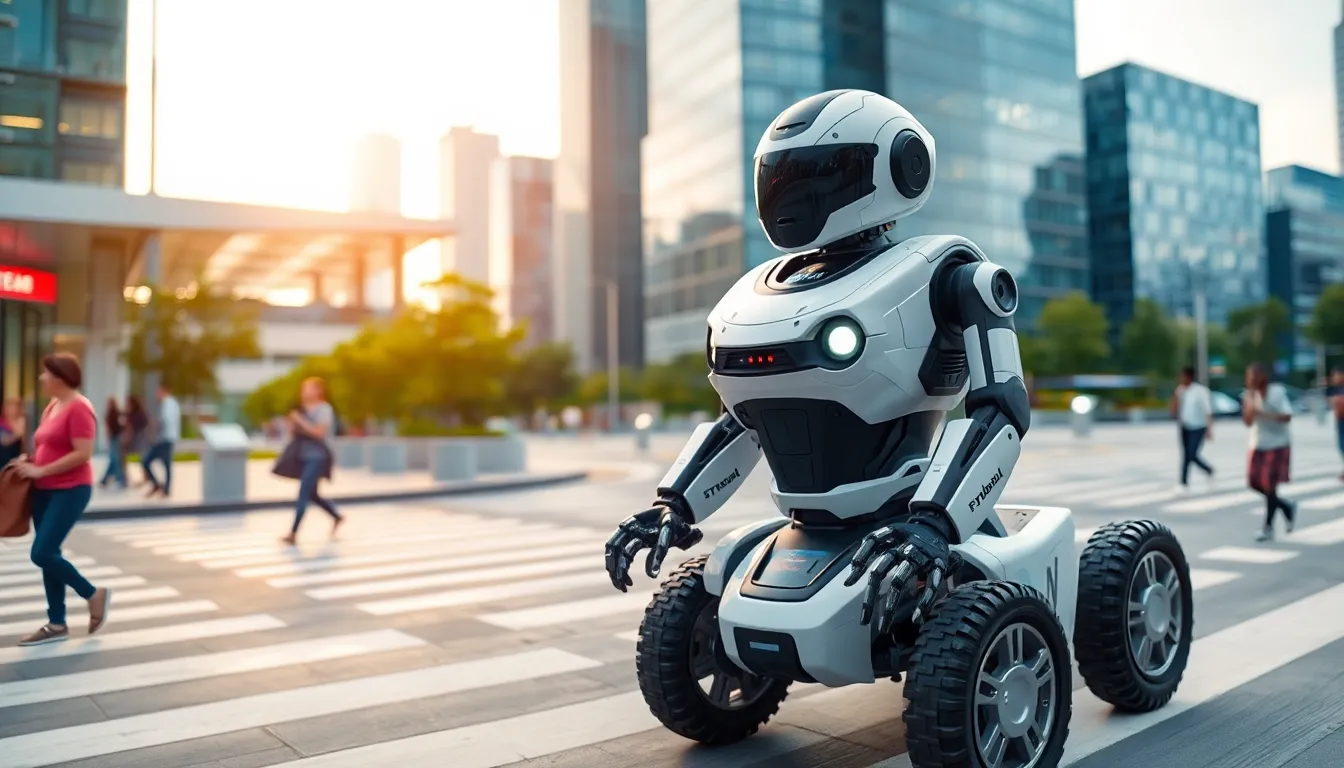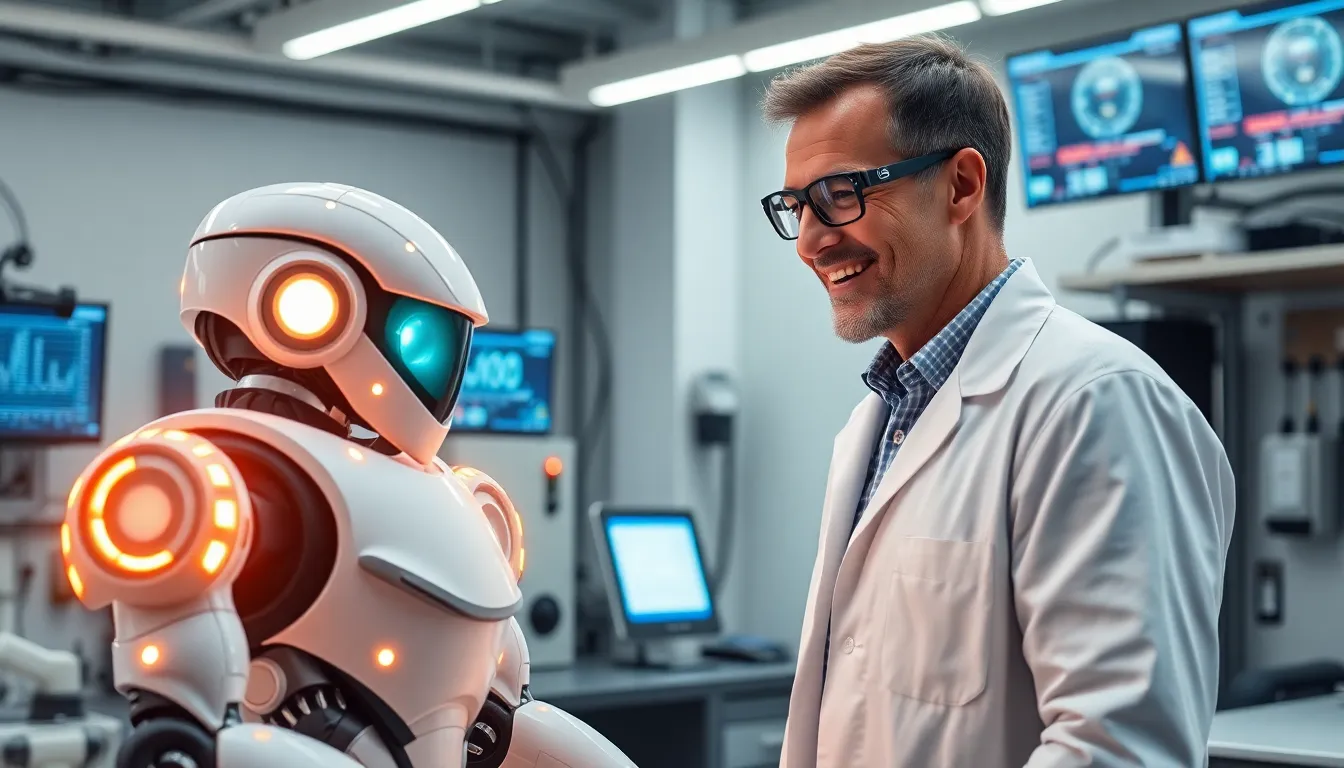The future of robotics is unfolding at an astonishing pace, with next-gen robot technology poised to transform industries and everyday life. These advanced machines aren’t just about automation; they’re designed to learn, adapt, and interact in ways previously thought impossible. From healthcare to manufacturing, the applications of this technology are vast and varied.
As artificial intelligence and machine learning converge with robotics, the potential for innovation expands exponentially. Imagine robots that can assist in surgeries or navigate complex environments autonomously. This evolution is not just enhancing efficiency but also redefining human-robot collaboration. Embracing these advancements could lead to breakthroughs that change the way society functions, making it crucial to stay informed about the latest developments in next-gen robot tech.
Table of Contents
ToggleOverview of Next-Gen Robot Tech
Next-gen robot technology integrates advanced artificial intelligence, machine learning, and innovative sensors to create highly capable robots. These robots adapt to their surroundings, learn from experiences, and interact with humans effectively. Industries like healthcare, manufacturing, and logistics benefit significantly from these advancements.
Key Developments
- Human-Robot Collaboration
Next-gen robots enhance collaborative tasks between humans and machines. They assist in surgeries, provide support in manufacturing lines, and streamline logistics operations.
- Autonomous Navigation
Robots equipped with sophisticated navigation systems can move through complex environments independently. They utilize LiDAR sensors, cameras, and advanced algorithms to map surroundings and avoid obstacles.
- Data Processing and Analytics
Advanced robotics rely on real-time data processing for efficient operation. Through machine learning, they analyze vast amounts of data, improving their decision-making capabilities.
- Social Interaction
Robots increasingly incorporate human-like interaction features. Speech recognition and natural language processing enable them to communicate and engage with users intuitively.
- Adaptive Learning
Next-gen robots utilize adaptive learning protocols that allow them to improve their performance based on past experiences. This capability enables them to adjust to new tasks and environments with minimal retraining.
Industry Applications
- Healthcare
Surgical robots assist physicians in procedures, enhancing precision and reducing recovery times. Robots also monitor patient health, delivering personalized care.
- Manufacturing
Automation robots increase productivity on assembly lines. They optimize workflows and reduce human error by performing repetitive tasks with high accuracy.
- Logistics
Autonomous delivery robots streamline logistics by carrying goods to designated locations. They navigate urban areas effectively, reducing delivery times and costs.
- Domestic Use
Home assistance robots help with daily tasks such as cleaning, monitoring, and even companionship, significantly enhancing quality of life.
Next-gen robot technology exemplifies the intersection of robotics and intelligent systems, driving innovations that reshape industries and everyday life.
Key Features of Next-Gen Robots

Next-gen robots showcase remarkable advancements that radically enhance their functionality and capabilities. These features significantly elevate their performance across various applications.
Advanced AI Integration
Advanced AI integration enables robots to process vast amounts of data and make intelligent decisions in real-time. State-of-the-art algorithms allow next-gen robots to learn from interactions and adapt their behavior based on environmental changes. For instance, healthcare robots employ AI to assist in surgeries by analyzing patient data and predicting outcomes, improving precision and efficiency.
Enhanced Sensor Technologies
Enhanced sensor technologies increase robots’ situational awareness, allowing them to perceive and interpret their surroundings accurately. Modern sensors, including LiDAR and advanced cameras, provide detailed environmental mapping in real-time. These innovations help robots navigate complex spaces autonomously, such as delivery drones locating optimal paths through urban environments to ensure timely arrivals.
Improved Mobility and Dexterity
Improved mobility and dexterity enable next-gen robots to perform intricate tasks with precision. Advanced actuators and flexible joints allow robots to mimic human-like movements, making them capable of delicate procedures, such as assembling intricate components in manufacturing. Enhanced mobility systems also empower robots to traverse diverse terrains, broadening their application spectrum to include explores in search-and-rescue missions.
Applications of Next-Gen Robot Tech
Next-gen robot technology finds applications across various industries, driving efficiency and innovation. Key sectors include industrial automation, healthcare, and consumer use.
Industrial Automation
- Manufacturing Efficiency: Robots facilitate rapid production processes, significantly reducing downtime and labor costs.
- Quality Control: Systems equipped with advanced sensors detect defects and anomalies, ensuring product standards.
- Collaborative Robotics: Cobots work alongside humans, enhancing productivity through safe interaction and shared tasks.
Healthcare Innovations
- Surgical Assistance: Robots enhance precision in complex surgeries, minimizing risks and recovery time.
- Patient Monitoring: Autonomous systems track vital signs and alert medical personnel to changes in conditions.
- Rehabilitation Support: Robots assist in physical therapy, helping patients regain mobility through adaptive training regimens.
Consumer and Household Robots
- Home Assistance: Robots perform tasks such as cleaning and cooking, improving daily life for individuals and families.
- Companion Robots: Socially interactive robots provide companionship and monitor the well-being of elderly or disabled users.
- Security Systems: Advanced robotics enhance home security through surveillance and automated threat detection.
Challenges Facing Next-Gen Robot Tech
Next-generation robot technology faces various challenges that impact its development and integration into society. These challenges include concerns around safety and security, as well as ethical implications that arise from advanced robotics.
Safety and Security Concerns
Safety is a priority in deploying next-gen robots. Potential malfunctions can occur, leading to accidents in environments where robots operate alongside humans. System failures may result in injuries or property damage, emphasizing the necessity for robust safety protocols. Additionally, security issues must be addressed, as embedded software vulnerabilities can expose robots to hacking and misuse. Protection against cyber threats is essential, particularly in sectors like healthcare and logistics, where sensitive data is at stake. Developers must implement stringent security measures and conduct thorough testing to mitigate these risks effectively.
Ethical Considerations
Ethical considerations in next-gen robotics influence public perception and acceptance. The integration of AI drives questions about job displacement, as automation may replace certain roles, impacting employment rates in various industries. Transparency in decision-making processes is crucial; robots should operate under begrijpable parameters to foster trust among users. Moreover, accountability for robotic actions poses challenges—if a robot causes harm, determining liability is complex. Addressing these ethical issues is vital for fostering a responsible approach to robotics, ensuring that advancements benefit society while minimizing negative consequences.
Future Trends in Robot Technology
Next-generation robot technology continues to evolve, promising significant impacts in various sectors. Emerging trends highlight how robotics will seamlessly integrate into everyday life and enhance efficiency across industries.
Robotics in Everyday Life
Robots increasingly play essential roles in daily tasks, enhancing convenience and efficiency. Home assistance robots perform chores, such as cleaning and cooking, enabling individuals to focus on more critical activities. Advanced surveillance systems offer security and peace of mind for homeowners. Social interaction tools, like companion robots, provide emotional support and companionship, particularly for the elderly. As affordability increases, more households adopt these technologies, integrating robots into standard daily routines.
The Role of AI and Machine Learning
Artificial intelligence and machine learning serve as the backbone of next-gen robotics. These technologies empower robots to analyze large volumes of data quickly, enhancing decision-making and operational efficiency. Through AI, robots recognize patterns in their environments, adapting their behaviors in real time. Machine learning enables continual improvement, allowing robots to refine performance based on experience. This combination fosters smarter robots that can handle complex tasks autonomously, ultimately reshaping industries such as healthcare, logistics, and manufacturing.
Next-gen robot technology is poised to redefine how industries operate and how individuals interact with machines. As these robots become more intelligent and adaptive they’ll not only enhance productivity but also improve the quality of life for many. The integration of AI and advanced sensors will enable robots to perform complex tasks with increased precision and efficiency.
While the potential is vast there are challenges that must be addressed to ensure safe and ethical implementation. Balancing innovation with responsibility will be crucial in building public trust. As advancements continue the future promises a world where robots and humans collaborate seamlessly in everyday life. The journey ahead is exciting and filled with possibilities that could transform society for the better.




